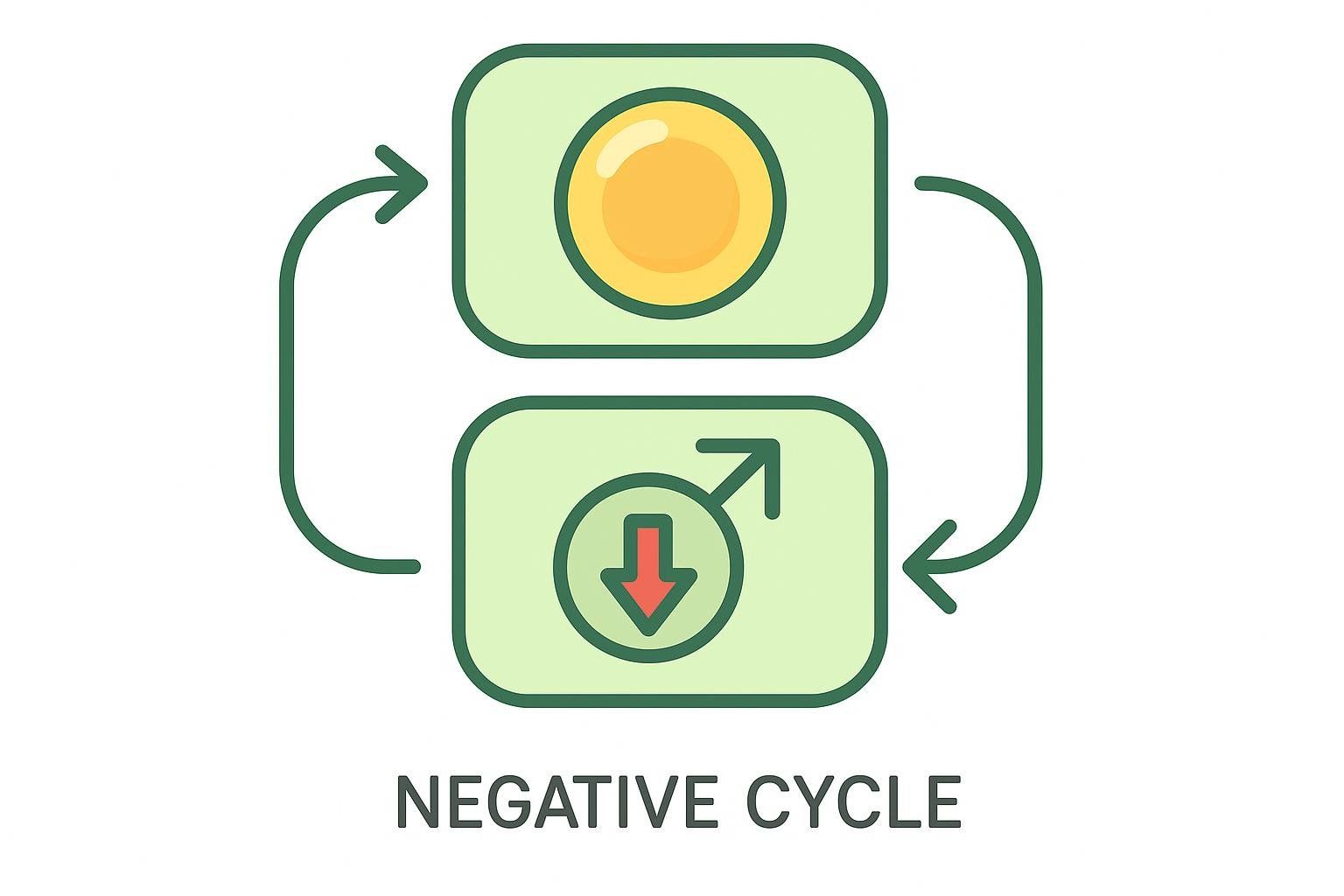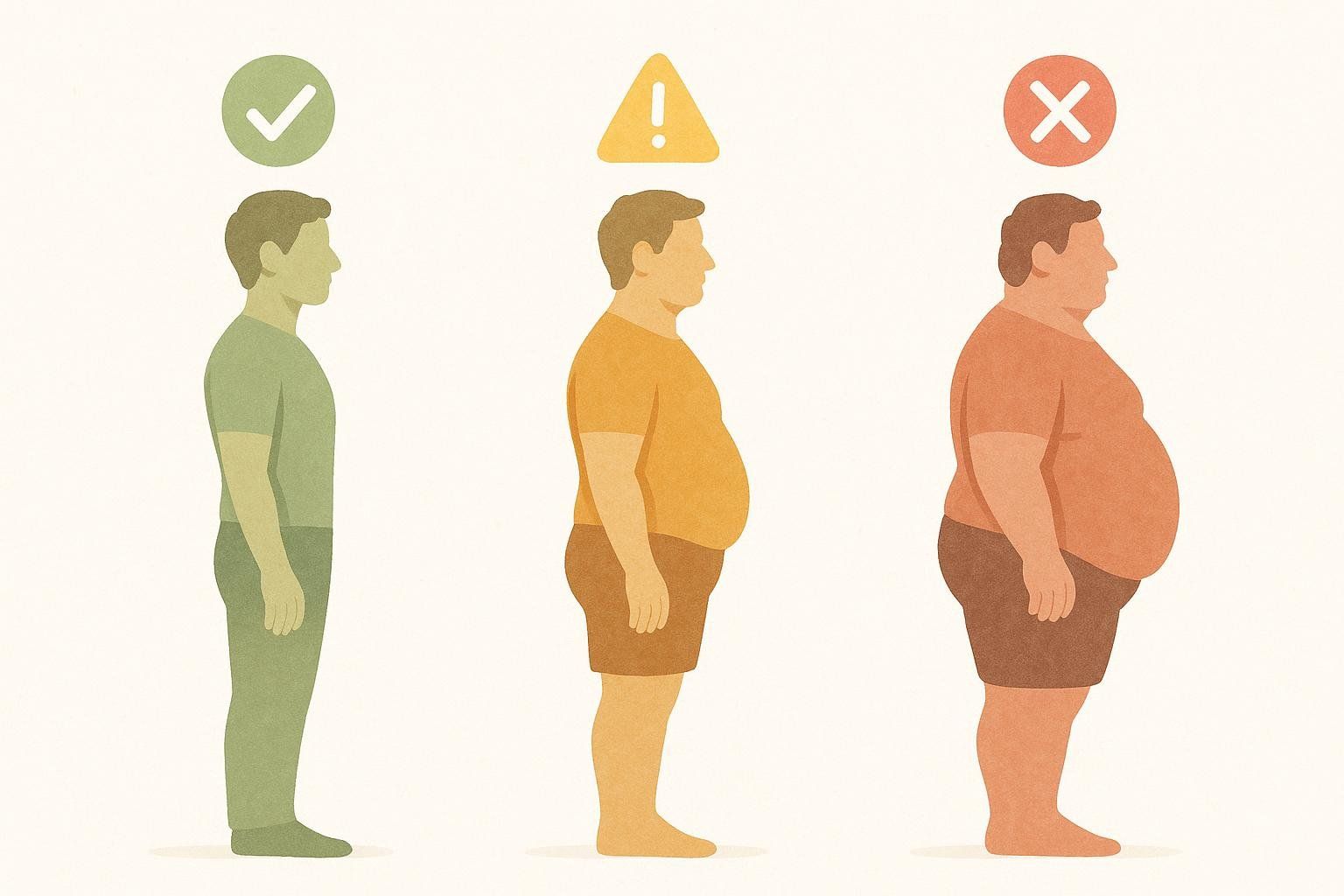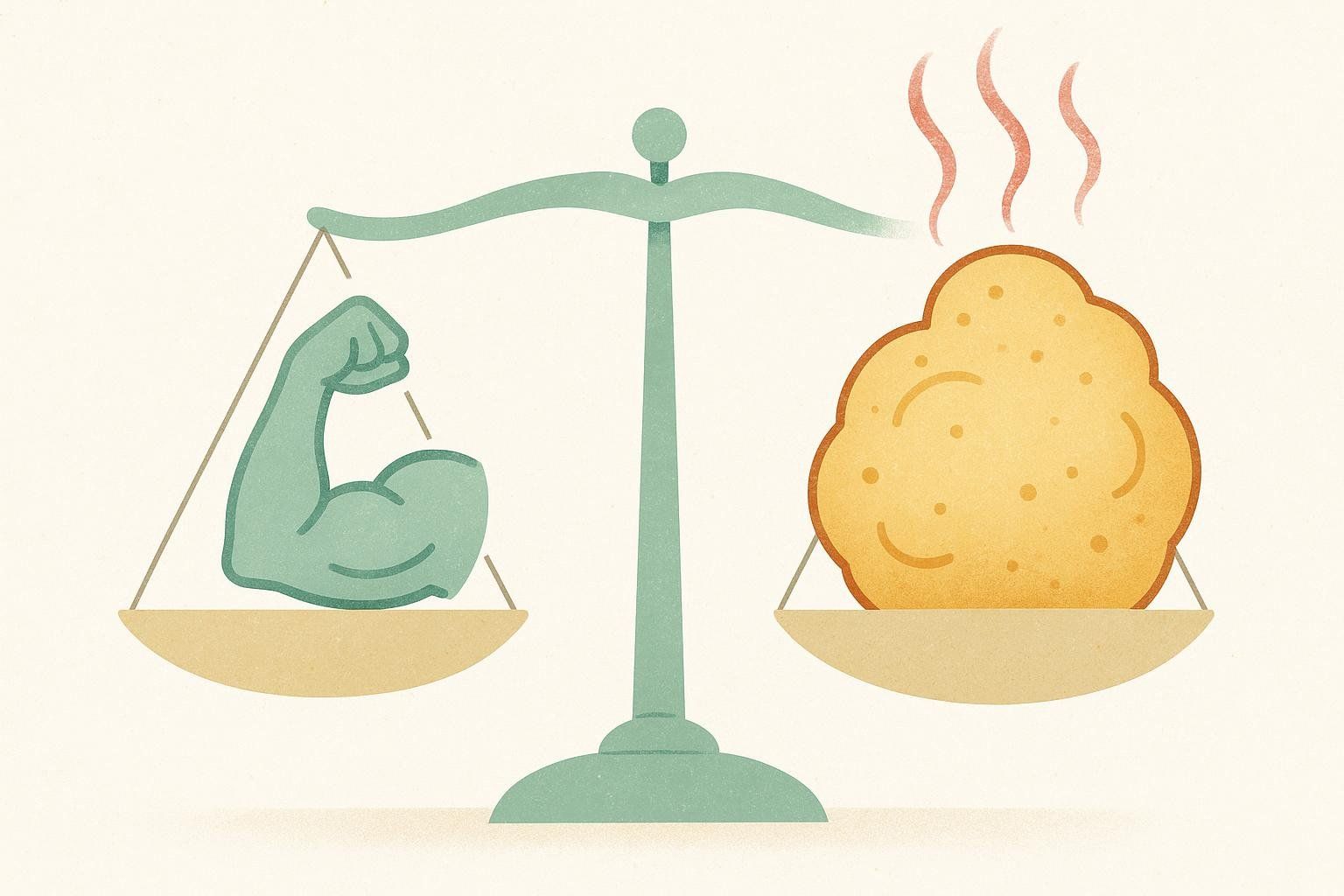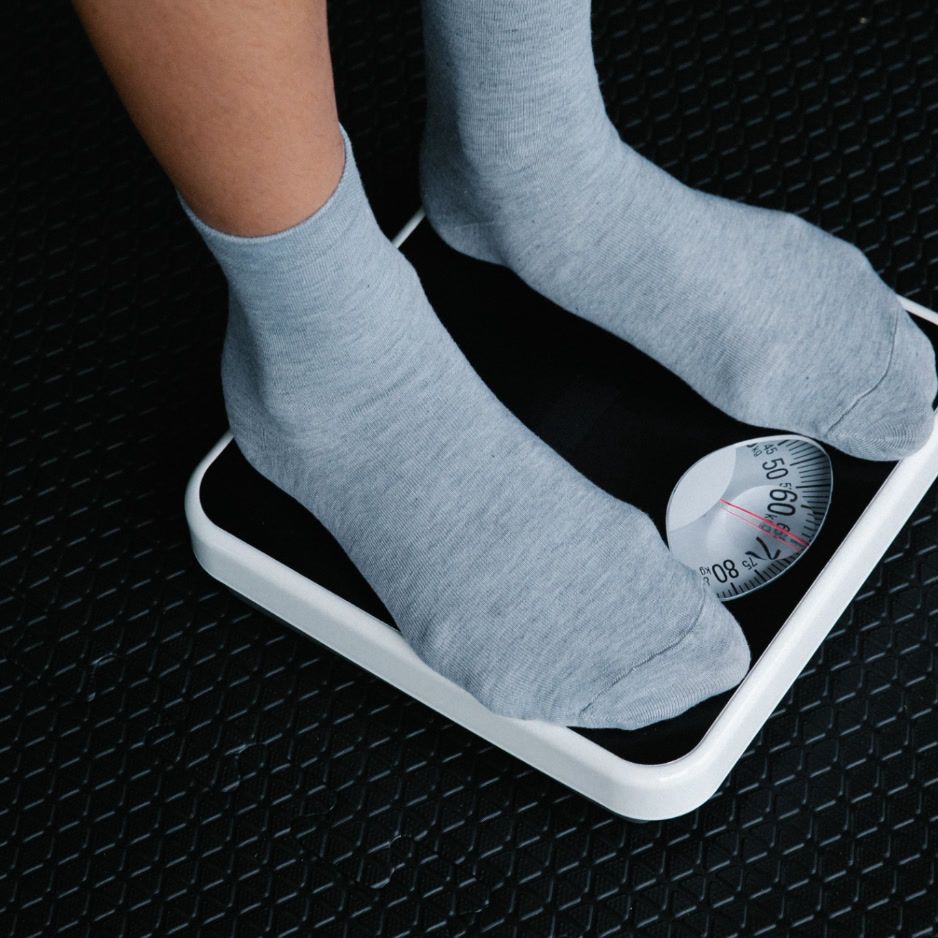Visceral Fat Range for Men: Healthy Levels, Risks & Reduction Strategies

Visceral Fat Range for Men: Healthy Levels, Risks & Advanced Reduction Strategies
TL;DR for Men
• Healthy range: Waist under 40 inches (102 cm), waist-to-hip ratio under 0.90, or DEXA visceral fat mass under 2 lbs (0.9 kg)
• Testosterone connection: Excess visceral fat suppresses testosterone; low T promotes more belly fat—breaking this cycle is crucial
• Action plan: Combine strength training + HIIT, prioritize protein, manage stress, and track progress with DEXA scans every 3-4 months
What Is the Healthy Visceral Fat Range for Men?
The healthy visceral fat range for men includes a waist circumference under 40 inches (102 cm), waist-to-hip ratio below 0.90, and DEXA-measured visceral fat mass under 2 pounds (0.9 kg). Men with measurements above these thresholds face significantly increased risks of cardiovascular disease, type 2 diabetes, and low testosterone. Unlike total body weight, visceral fat specifically measures dangerous deep abdominal fat that surrounds vital organs.
Visceral fat isn't just "belly fat"—it's an active endocrine organ that can hijack your hormones, metabolism, and long-term health. For men, excess visceral fat creates a particularly dangerous cycle: it suppresses testosterone while low testosterone promotes more visceral fat accumulation. This comprehensive guide breaks down healthy visceral fat ranges specifically for men, explains the testosterone connection, and provides targeted strategies whether you're a fitness enthusiast seeking optimization or managing health concerns.
What Is Visceral Fat and Why Does It Matter More for Men?
Visceral fat is the deep abdominal adipose tissue that wraps around your liver, pancreas, intestines, and other organs. Unlike the soft, pinchable subcutaneous fat under your skin, visceral fat acts like a metabolically active hormone factory, pumping out inflammatory cytokines and interfering with normal physiological processes (Cleveland Clinic).
The Male-Specific Visceral Fat Problem
For men, hormonal factors often lead to storing more fat in the abdomen (an "apple shape") rather than in the hips and thighs like women ("pear shape"). This pattern becomes more pronounced with age as testosterone levels naturally decline—creating a vicious cycle that demands targeted intervention.
**The Testosterone-Visceral Fat Cycle:

- Excess visceral fat converts testosterone to estradiol via the enzyme aromatase
- Low testosterone reduces muscle mass and metabolic rate
- Slower metabolism promotes further fat storage, especially visceral fat
- The cycle accelerates (PMC study on visceral adiposity and testosterone)
Healthy Visceral Fat Ranges for Men

Quick Assessment Methods
| Method | Healthy Range (Men) | Increased Risk | Source |
|---|---|---|---|
| Waist Circumference | < 40 in (102 cm) | ≥ 40 in (102 cm) | WHO Expert Consultation |
| Waist-to-Hip Ratio | < 0.90 | ≥ 0.90 | WHO Expert Consultation |
| DEXA Visceral Fat Mass | < 2 lbs (0.9 kg) | ≥ 2 lbs (0.9 kg) | BodySpec threshold based on client outcomes |
| DEXA Visceral Fat Area | < 100 cm² | 100-130 cm² (elevated) | European Reference Study |
Special Considerations by Age and Risk Factors
As men age, visceral fat naturally increases due to declining testosterone, slower metabolism, and lifestyle factors.
Key monitoring points:
- 20s-30s: Establish baseline measurements and healthy habits
- 40s: Monitor for accelerated accumulation due to hormonal changes
- 50+: Consider comprehensive metabolic assessment if waist exceeds healthy ranges
Higher risk groups requiring closer monitoring:
- Family history of diabetes or heart disease
- Sleep apnea or chronic sleep deprivation
- High stress occupations
- Taking certain medications (corticosteroids, some antidepressants)
The Male Health Impact: Beyond the Scale
Understanding how visceral fat specifically affects men's health requires examining both immediate and long-term consequences.
Testosterone and Sexual Health
Research consistently shows that men with higher visceral fat have:
- Lower total and free testosterone levels (PMC testosterone study)
- Increased risk of erectile dysfunction
- Reduced sperm quality and fertility
- Higher estradiol-to-testosterone ratios
A 2022 Nature study confirmed the direct link between muscle mass and testosterone: even after accounting for other metabolic issues, higher muscle mass was associated with higher testosterone, highlighting the importance of preserving lean mass during visceral fat reduction.
Cardiovascular and Metabolic Risks
Men with waist circumferences above 40 inches face:
- 2x risk of cardiovascular disease (Harvard Health)
- Significantly increased type 2 diabetes risk - Research from Johns Hopkins found that waist circumference is an even better predictor of type 2 diabetes risk in men than BMI
- Increased blood pressure and insulin resistance
- Higher risk of sleep apnea
The Hidden Muscle Connection
Visceral fat doesn't just store energy—it creates an inflammatory environment linked to muscle breakdown. Research shows that elevated levels of inflammatory cytokines like IL-6 and TNF-α, which are produced by visceral adipose tissue, are associated with both increased visceral fat and reduced muscle mass in aging populations (BMC Geriatrics study). Men with high visceral fat often experience accelerated sarcopenia (muscle loss), creating a compounding effect on metabolism and functional capacity.

Measurement Deep Dive: From Tape to DEXA
DIY Assessment (Start Here)
The 5-Minute Male Visceral Fat Check:
- Waist measurement - Place tape at navel level, exhale normally
- Hip measurement - At widest point of hips/buttocks
- Calculate waist-to-hip ratio - Divide waist by hip measurement
- Height comparison - Divide waist by height for waist-to-height ratio
Red flags for immediate action:
- Waist ≥ 40 inches AND gaining weight
- Waist-to-hip ratio ≥ 0.90
- Rapid waist growth (>1 inch in 6 months)
Advanced Tracking with DEXA
While tape measures provide quick screening, DEXA scans offer precision that transforms your approach to body composition management:

| DEXA Advantage | Why It Matters for Men |
|---|---|
| Separate visceral from subcutaneous fat | Distinguish dangerous deep fat from cosmetic surface fat |
| Track muscle mass simultaneously | Monitor testosterone-related muscle changes |
| Regional analysis | Identify android vs. gynoid fat patterns |
| Progress validation | Confirm tape-measure improvements with precise data |
Recommended DEXA schedule for men:
- Initial assessment - Establish baseline
- Every 3-4 months during active fat loss
- Twice yearly for maintenance monitoring
- More frequently if managing diabetes or low testosterone
Male-Specific Reduction Strategies
The Three-Tier Approach
Tier 1: The Foundation Approach
This foundational approach is ideal for men over 40 who are noticing waistline expansion and seeking clear guidance.

Phase 1 (Weeks 1-4): Foundation
- Exercise: 30-minute walks daily, 2x/week bodyweight circuits
- Nutrition: Eliminate liquid calories, add protein to every meal
- Sleep: Establish 7-8 hour sleep routine
- Tracking: Weekly waist measurements
Phase 2 (Weeks 5-12): Acceleration
- Exercise: Add 2x/week gym sessions (squats, deadlifts, presses)
- Nutrition: Adopt Mediterranean diet; prioritize protein at 1.2-1.6g per kg of body weight
- Stress: 10 minutes daily meditation or breathing exercises
- Tracking: Follow-up DEXA scan at end of phase, weekly weigh-ins
Primary goals: 2-4 inches waist reduction, improved energy, better sleep quality
Tier 2: The Optimization Approach
This optimization approach is perfect for fitness enthusiasts seeking advanced strategies and data-driven results.
Here is a sample advanced training cycle:
- Week A: Upper/Lower split + 2x HIIT (15 min cycling intervals)
- Week B: Push/Pull/Legs split + 2x HIIT (rowing sprints) + 1x LISS (Low-Intensity Steady-State cardio)
- Week C: Deload week with moderate intensity across all sessions (recovery week)
Precision Nutrition:

- Macros: Start with a 40/30/30 macro split (carbs/protein/fats) and adjust based on performance, satiety, and biofeedback
- Timing: Prioritize carbohydrates in pre- and post-workout meals, with other meals centered on protein and healthy fats
- Advanced tactics: 16:8 intermittent fasting (can improve insulin sensitivity and enhance fat oxidation), carb cycling on training days (higher carbs on workout days to fuel performance while maintaining metabolic flexibility)
Science-Backed Supplements:
- Creatine monohydrate: 5g daily for muscle preservation
- Vitamin D3: 2000-4000 IU daily, but confirm deficiency with a blood test before supplementing as adequate levels are crucial for testosterone production
- Omega-3: 2-3g EPA/DHA daily for inflammation control
Primary goals: Measurable reduction in DEXA-scanned visceral fat mass and improved body composition metrics
Tier 3: The Health Recovery Approach
This health recovery approach is designed for men managing diabetes, high blood pressure, or metabolic syndrome.
Medical Integration Approach:
- Cardio foundation: Start with 10-minute walks after meals
- Resistance training: Chair exercises progressing to light weights
- Nutrition: Focus on blood sugar stability with complex carbs and lean proteins
- Medical monitoring: Coordinate with healthcare provider for medication adjustments
Key metabolic targets:
- Fasting glucose: < 100 mg/dL
- HbA1c: < 5.7% (below the pre-diabetes threshold)
- Blood pressure: < 130/80 mmHg
- Waist circumference: Primary focus over weight loss
Advanced Male-Specific Considerations
Hormonal Optimization
Natural testosterone support strategies:

- Strength training: Compound movements, progressive overload
- Adequate fats: 25-30% of calories from healthy sources
- Zinc and magnesium: Consider supplementation if deficient
- Sleep quality: Deep sleep critical for testosterone production
- Stress management: Chronic stress significantly lowers testosterone
When to consider medical intervention:
- If you have symptoms and blood tests reveal low testosterone levels (a common clinical threshold is below 300 ng/dL, but it's crucial to discuss this with a doctor)
- Rapid visceral fat gain despite lifestyle efforts
- Presence of multiple metabolic syndrome markers (e.g., high blood pressure, high blood sugar, low HDL cholesterol, high triglycerides)
The Alcohol Factor
Men typically consume more alcohol than women, and this significantly impacts visceral fat:
- The "beer belly" connection: Studies show a positive association between beer consumption and waist circumference in men, with higher consumption linked to increased waist gain risk
- Threshold effect: Research on alcohol's effects shows that men consuming more than 20 grams of alcohol daily (roughly 1.5-2 standard drinks) have significantly larger waist circumferences than non-drinkers
- Recovery impact: Alcohol disrupts deep sleep needed for hormone production
Practical limits: Maximum 14 drinks per week with at least 2 alcohol-free days
Age-Related Strategies
30s optimization:
- Focus on building muscle mass as "metabolic insurance"
- Establish consistent exercise habits before family/career demands peak
- Monitor waist measurements monthly
40s intervention:
- Prioritize stress management as cortisol sensitivity increases
- Consider periodic fasting protocols
- Get baseline hormone panel (testosterone, thyroid, insulin)
50+ intensive approach:
- Work with healthcare provider on comprehensive metabolic assessment
- Consider TRT if appropriate
- Emphasize functional strength to maintain independence
Tracking and Accountability
The Male Progress Dashboard
Weekly metrics:
- Weight (same time, same scale)
- Waist circumference
- Energy levels (1-10 scale)
- Sleep quality (hours + subjective rating)
Monthly assessments:
- Progress photos (front, side, back)
- Strength benchmarks (push-ups, plank time)
- Advanced metrics if available (blood pressure, resting heart rate)
- DEXA scan with visceral fat analysis
Quarterly deep dives:
- Blood panel (glucose, lipids, testosterone if indicated)
- Program adjustment based on data
Troubleshooting Common Male Challenges
"I'm losing weight but my waist isn't shrinking"
- May indicate muscle loss rather than fat loss
- Research suggests active men need 1.2-1.6g of protein per kg of body weight to preserve muscle during weight loss
- For a personalized nutrition plan, consider consulting a nutrition professional
- Prioritize adding resistance training
- Consider shorter, more aggressive cut cycles
"My testosterone is low but I can't lose belly fat"
- Visceral fat and low T create a vicious cycle
- Work with endocrinologist on hormone optimization
- Focus on stress reduction and sleep quality (high cortisol and poor sleep directly promote visceral fat storage)
- Consider medical weight loss support
"I travel frequently for work"
- Portable resistance bands for hotel workouts
- Research healthy options at common destinations
- Pack protein powder for consistent intake
- Use travel time for walking in airports
Action Steps: Your Next 30 Days
Week 1: Assessment and Setup
- Measure waist circumference 3 times, record average
- Calculate waist-to-hip and waist-to-height ratios
- Schedule DEXA scan within 2 weeks
- Establish baseline measurements (weight, photos)
Week 2: Foundation Building
- Start daily 20-30 minute walks
- Add protein source to every meal
- Eliminate liquid calories (soda, juice, beer)
- Set up sleep routine (same bedtime/wake time)
Week 3: Exercise Addition
- Join gym or set up home exercise space
- Complete 2 full-body strength workouts
- Continue daily walking
- Track everything in app or journal
Week 4: Optimization
- Add 1-2 HIIT sessions per week
- Review and adjust nutrition based on progress
- Assessment: re-measure waist, compare to Week 1
- Plan next 30-day cycle based on results
When to Consider Professional Help
Red flags requiring medical consultation:
- Waist circumference growing despite diet/exercise efforts
- Blood pressure consistently above 130/80 mmHg
- Family history of early heart disease or diabetes
- Symptoms of low testosterone (low energy, mood changes, reduced libido)
Types of professional support:
- Primary care physician: Basic metabolic assessment and risk stratification
- Endocrinologist: Hormone evaluation and treatment
- Registered dietitian: Personalized nutrition planning
- Certified trainer: Exercise program design and accountability
FAQ for Men
Q: What's the fastest way to reduce visceral fat?
A: High-Intensity Interval Training combined with a moderate calorie deficit (15-20% below maintenance) consistently outperforms other approaches. A meta-analysis of 39 studies found that HIIT significantly reduced visceral fat mass, with most men seeing measurable changes in 8-12 weeks.
Q: Can I spot-reduce belly fat with ab exercises?
A: No. Crunches and planks strengthen abdominal muscles but don't preferentially burn visceral fat. Full-body strength training and cardio are necessary for fat reduction.
Q: How much visceral fat loss improves testosterone?
A: Research hasn't identified a precise threshold, but studies show a strong relationship between excess visceral fat and low testosterone. Harvard Health reports that a four-inch increase in waist size increases a man's odds of having low testosterone by 75%. Additionally, men who achieve significant fat loss through lifestyle changes or bariatric surgery often see dramatic testosterone improvements, suggesting meaningful visceral fat reduction can positively impact hormonal health.
Q: Is visceral fat harder to lose than subcutaneous fat?
A: Actually, visceral fat often responds faster to diet and exercise because it's more metabolically active. The challenge is that it's easier to regain if healthy habits aren't maintained.
Q: Should I consider testosterone replacement therapy?
A: Only after addressing lifestyle factors and working with a qualified physician. Many men see significant testosterone improvements from visceral fat reduction alone, making TRT unnecessary.
Q: How accurate are smart scales for measuring visceral fat?
A: Consumer bioelectrical impedance scales can give general trends but have significant error margins. A study in PMC found that while smart scales were reasonably accurate for body weight, they were not accurate for body composition, with fat mass being globally underestimated by all tested devices. DEXA scanning provides clinical-grade accuracy for tracking meaningful changes.
Key Takeaways: Your Visceral Fat Action Plan
- Know your numbers: Waist under 40 inches is the minimum target; under 37 inches is optimal
- Break the testosterone-fat cycle: Simultaneous focus on muscle building and fat loss
- Use the three-tier approach: Match strategy to your current fitness level and goals
- Track precisely: DEXA scans every 3-4 months provide the data needed for course corrections
- Think long-term: Sustainable 1-2 pound weekly loss preserves muscle and prevents rebound
Ready to take control of your visceral fat and optimize your health? Book a BodySpec DEXA scan to establish your baseline and start tracking progress with precision data.


